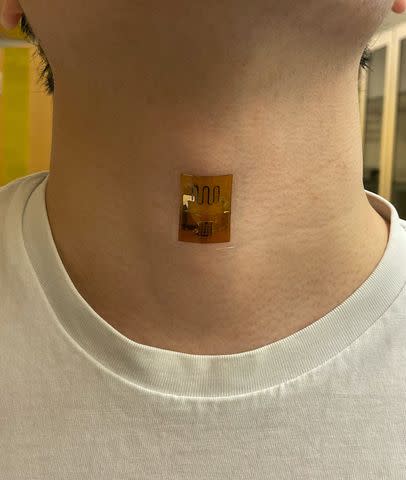These Zombie Bacteria May Power Your Wearables in the Future

"Hearst Magazines and Yahoo may earn commission or revenue on some items through the links below."
Geobacter sulfurreducens, a type of bacteria found in sedimentary, low-oxygen environments, can turn moisture into electricity.
Typically, the bacteria need to be kept alive to generate power, but scientists have found a way to use dead ones encased in a biofilm.
The biofilm supplied power to multiple small-sized electronics, but isn’t powerful enough yet to charge a smartwatch or larger mobile devices.
Imagine this: It’s a hot summer day and while you would like to stay cool inside, Fido’s begging for a walk. Out and about, you’re listening to your favorite true crime podcast when disaster strikes—the trill of a perilously low battery. With no portable charger on you, you almost panic, but then remember your handy stash of microbial batteries, tiny paper-thin squares containing electricity-producing bacteria.
You stick a square to your sweaty skin and hook it up to your phone. It goes from nil to nearly fully charged as the microbes drink up the moisture, transmuting it into electrical juice. With a happy green bar of health, you can get back to your episode on the Zodiac Killer with sweet Fido none the wiser.
🦠 Science explains the world around us. We’ll help you make sense of it all. Join Pop Mech Pro.
This scenario is entirely made up, but is far from a sci-fi pipe dream. According to a study published July 28 in the journal Nature Communications, batteries made of bacteria could very well be the future of electricity. Researchers at the University of Massachusetts Amherst have engineered a biofilm containing a special type of bacteria called Geobacter sulfurreducens, which is capable of generating an electrical current from water.
“This is a very exciting technology,” Xiaomeng Liu, the new study’s lead author and a graduate student at UMass Amherst’s College of Engineering, tells Popular Mechanics. “It is real green energy unlike other so-called green-energy sources. Its production is totally green.”
Bacteria Batteries
Using bacteria as a battery may seem like an unusual choice, but it’s not unprecedented. The move toward generating energy from renewable, natural sources—A.K.A. green energy—has involved bacteria-powered solar panels and even methane-chomping microbes. G. sulfurreducens belongs to a far-reaching family of electroactive bacteria that naturally produce electricity when feeding on organic compounds. They do this by stripping off electrons and transferring them to iron oxide (our bodies replicate the same action, but instead hand off the electrons to oxygen).
To get to iron oxide, G. sulfurreducens and other Geobacter species do something very curious: sprout wire-like tendrils called pili (pilus for one). These tendrils, dubbed nanowires (pictured at the top of this story), draw electrical current away from the bacteria to the metal source, and can send electricity to other species of microbes, The New York Times reported in 2019.
In the last decade or so, there’s been a huge focus on conscripting these electroactive bacteria for a wide variety of applications. But because Geobacter needs to be alive in order to generate electricity (remember the whole munching on organic matter?), keeping them well-fed is more of a design hassle than a useful innovation.
But what if the bacteria don’t need to be kept alive? Can they still produce electricity?
One “Big” Microbial Circuit
That very question led the UMass Amherst researchers to develop a biofilm, a thin sheet made of genetically engineered G. sulfurreducens growing around each other in colonies about as thick as a sheet of paper. This biofilm is sandwiched between two mesh electrodes, which transfer the electrons from the biofilm. Sealing everything together is a sustainably-produced polymer providing structure.
Liu explains that when there’s moisture in the environment—whether sweat on the skin or humidity in the air—the biofilm takes electrons from water or evaporation to produce a running electrical current. Even though the bacteria in the film are dead, the researchers believe what’s allowing this process to transpire are proteins inside the bacterial cells that help move electrons around, as well as the nanowires between the bacteria themselves.
And even though G. sulfurreducens is dead, the difference in electrical performance doesn’t appear to be hampered all that much, according to Liu. The team was able to use its biofilm to power a small LCD screen and sensors measuring strain, pulse, respiration, and glucose, although not all at once.

“We’ve simplified the process of generating electricity by radically cutting back on the amount of processing needed,” Derek Lovley, one of the paper’s senior authors and a professor of microbiology at UMass Amherst, says in a press release. “We sustainably grow the cells in a biofilm, and then use that agglomeration of cells. This cuts the energy inputs, makes everything simpler, and widens the potential applications.”
Harkening back to our imagined summer-day scenario, the biofilm isn’t yet powerful enough to charge a cellphone or a wearable like an Apple Watch. There’s also the question of exactly how long these microbial batteries last—Liu says it could be beyond six months, but this needs more studying. The UMass Amherst team hopes to address and improve upon these issues with upcoming iterations.
“For the next steps, we want to extend [how long] the devices last [and] we want to prepare a large-scale array to increase the power output of our devices,” he says. “Maybe in the future, we can power up a whole system of wearable electronics.”
A legion of sweat-snacking, electricity-zapping zombie bacteria powering electronics big and small? Why not?
You Might Also Like

 Yahoo Movies
Yahoo Movies 